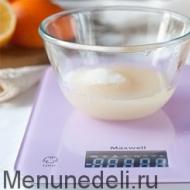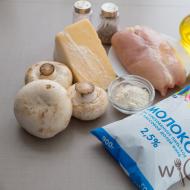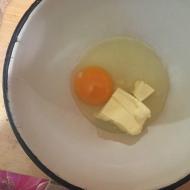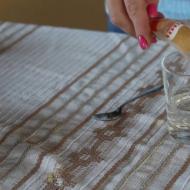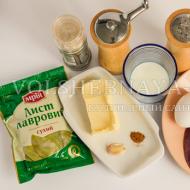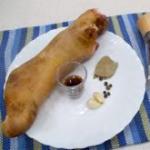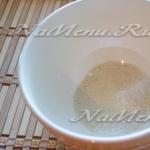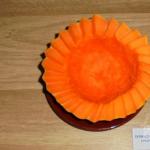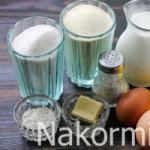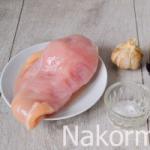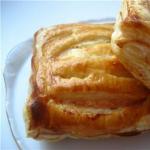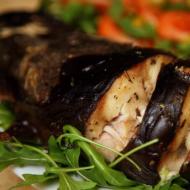
What can you make from Camembert cheese? Recipes with cheese. drain pan with grate
This makes a good hot breakfast, dessert or snack. The slightly pungent taste of the cheese and its consistency become even more interesting after baking - spicy herbs will complement the taste of the cheese, the core will be even softer and against this background the dense crust will feel brighter.
Due to the fact that this recipe does not require any effort, as well as a long time for preparation, it is very convenient in situations of “unexpected guests on the doorstep”.
Now on sale, in addition to the classic French Camembert, there are many inexpensive types of this cheese from various German and Danish manufacturers.
These inexpensive cheeses perform very well when baked, so it is not at all necessary to spend a lot of time and money to purchase French cheese.
For baked camembert you will need:

- Camembert.
- Thyme (thyme).
- Freshly ground black pepper.
You can use rosemary instead of or together with thyme. You can also use garlic or other aromatic herbs that you like.
I like the combination of cheese with strawberry jam, so most often I use it for the same cheese plate.
|
|
|---|
Preparing baked camembert.
If your Camembert was sold in a round wooden or cardboard box, then you need to wet this box before baking. It is enough to immerse a cardboard box in water for 15-30 seconds. Wooden - for 2-3 minutes.
Turn on the oven and preheat it to 200ºC.
You can also use baking molds - everything is much easier with them.
Place the camembert circle in a mold lined with baking paper and use a thin, sharp knife to cut through the top crust of the cheese in the form of a grid. The depth of the cut is small - approximately 5 mm.
Chop the thyme leaves very finely and sprinkle them over the cheese. Add some freshly ground black pepper.

If you use garlic, then the garlic clove is cut into plates, which are inserted completely into the slits in the cheese.
Rosemary can simply be cut into short sprigs - about 3 cm long and stuck into the cheese until the middle.
Place the molds (or soaked packaging boxes, also lined with baking paper) with cheese in an oven preheated to 200ºC for about 10-15 minutes.
Much depends directly on the oven.
The readiness of the cheese is determined as follows: the mesh cuts have widened and the top crust of the cheese has risen.

This product is highly valued by gourmets from different parts of the world. True connoisseurs eat the delicacy, washed down with neutral varieties of wine, which do not overwhelm the complex taste of the cheese, but somewhat soften its sharpness. Camembert is included in many French cuisine recipes: it complements desserts, soups, and various sauces.
What is camembert
The product comes from France, but has won the love of millions of people from around the world. Camembert is a soft, high-fat cheese made from high-quality cow's milk (to obtain the delicate taste of the product, cattle are grazed on special pastures). The finished delicacy can have a color from snow-white or light beige to dark brick, and its aroma resembles the smell of dampness, while the more mature the cheese, the brighter the smell. The heads weighing approximately 300 grams are covered with a white crust, which is formed by a special type of mold.
The smell of Camembert
Not everyone likes the aroma of the Normandy delicacy: it resembles the smell of rottenness, and the harshness depends on the degree of aging of the product. If you feel that the smell of Camembert is ammonia-like or too pungent, this indicates that the product has gone bad. Real French cheese only comes with a creamy taste. Other types, with additives such as mushrooms, bacon, garlic, cannot be called Camembert. The taste of the delicacy is spicy and spicy, with a subtle aftertaste of cream. At the same time, the middle of the product is soft, and the mold crust is dense.
What is the difference between Brie and Camembert cheese?
Externally, both types of product are similar - there is white mold on their surface. What is the difference between brie and camembert? The main feature of Camembert is its higher fat content and soft consistency. So, even at room temperature, the delicacy begins to quickly melt inside. Brie and Camembert cheese also differ in shape: the first is triangular, and the second is round. The Camembert crust has a sharper taste and a bright egg-mushroom aroma. The smells of the cheeses also differ: the aroma of brie is more like ammonia, and the moldy surface is almost tasteless.
Benefits of camembert cheese
The beneficial properties of the product are explained by its composition: cheese contains a lot of vitamins, amino acids, and microelements. Nutritionists advise including the variety even in the diet of those people who are lactose intolerant, since Camembert contains extremely little of it. To improve health and prevent the development of various diseases, a person should eat only 20-50 grams of the product per day. What other benefits of Camembert cheese are there:
- the delicacy helps treat gastrointestinal diseases and prevents cardiovascular pathologies;
- thanks to phosphorus and calcium in the product, it is able to strengthen the skeletal system, preventing fractures, arthrosis, etc.;
- Since cheese mold includes substances that produce melamine, eating the treat helps protect your skin from sunburn;
- Camembert has a positive effect on the condition of teeth and prevents the onset of caries.
Calorie content of blue cheese
Among the mass of varieties of products that are produced with mold, Camembert stands out. In the process of making this type of cheese, porcini mushrooms of the genus Penicillium candidum and Penicillium camemberti are used. The calorie content of blue cheese is approximately 300-340 kcal per 100 grams of the delicacy. However, the nutritional value and calorie content of a dish may vary depending on the cooking technology and ingredients used.
How to eat Camembert cheese correctly
Since cheese has a high fat content, it hardens at low temperatures, becoming hard like butter. If the treat is served in this state, the taste and smell of the treat will be indistinguishable. How to eat Camembert? You need to eat the cheese in a thawed form, taking it out of the refrigerator in advance and cutting it into portions (like a cake) rather than into thin pieces. Before eating Camembert cheese, you need to give the delicacy time to reach room temperature. What do you eat Camembert with? The table is served with nuts, fruits, and fresh baguette. It is appropriate to add fresh herbs and rose wine to the treat.
Camembert at home
The product is easier to prepare than hard varieties, which require long-term processing of the granular mass, a long process of oxidation and squeezing under high pressure. To make Camembert at home, you only need milk, mesophilic starter culture, salt and rennet. In this case, it is better to purchase the base from farmers who graze cows in the meadows. Cheese made from such milk will be much tastier and healthier. For the delicacy to ripen, the refrigerator should be about 11-13 degrees Celsius and air humidity 85-95%. How to prepare Camembert cheese with white mold:
- milk is poured into a saucepan, put on fire and heated to 32 degrees;
- in ¼ tbsp. water dissolves mesophilic starter;
- then the starter is poured into the warm milk, the mixture is stirred and its surface is sprinkled with white mold and Geotrichum Candidum (both on the tip of a knife);
- the powder should be absorbed into the moisture, then the mixture is mixed, moving with a spoon from bottom to top, distributing it throughout the entire volume of milk;
- then add 10 mg of calcium chloride to the cheese base;
- after 10 minutes, 1 gram of milk-clotting enzyme dissolved in 50 ml of water is sent into the container;
- After mixing, leave the mass for 40 minutes (during this period the product becomes dense and jelly-like);
- Next, cut the cheese into small cubes, let stand for 8 minutes to drain off excess liquid and warm the mass again to 32 degrees, stirring (it is better to use a ceramic or iron spoon);
- the grain is allowed to brew for 20 minutes, then the whey is poured into a separate container, and the cheese mass is distributed into molds, taken by hand or with a slotted spoon;
- the base is given the desired shape by pressing the grain and leaving it for a couple of hours, then turn the cheese over to the other side (so the mass will gradually slide down and become even more compact under its own weight);
- the product is turned over every 30 minutes for 4 hours;
- after the camembert is left to ripen in a plastic container lined with paper napkins (a tray is placed under them to collect excess liquid);
- As the paper gets wet, the napkins are changed, the heads of cheese are turned over every day;
- after 2 weeks, mold covers the entire surface of the product, then the cheese is wrapped in paper and left in the refrigerator for up to 4 weeks until fully ripened.

Camembert cheese price
The authentic product is produced in the provinces of France, so it is worth purchasing cheese that has this country on the label. To ensure the authenticity of Camembert, check for the characteristic stripes that are imprinted on the cheese when it ripens on the racks. Experts recommend choosing young varieties that are covered with light-colored mold and have a delicate aroma. The approximate price of Camembert cheese sold in Moscow is (per head):
- for young cheese – approximately 250 rubles;
- for a mature product – up to 350 rubles;
- for cheese with a long ripening period - about 500 rubles.
Recipes with Camembert cheese
Gourmets love to eat the delicacy with light wine, then they can feel the whole bouquet of cheese flavors. Camembert is especially revered in France, where it is served with fresh bread and used to prepare various salads, sauces, first courses, and desserts. Often recipes with Camembert cheese involve baking the product, which makes it slightly viscous and softens the taste and aroma. An excellent option for using cheese is to prepare all kinds of pies, casseroles, pizza, sandwiches, etc.
Fried camembert cheese
- Number of servings: for 3 persons.
- Calorie content of the dish: 291 kcal/100 g.
- Purpose: snack.
- Cuisine: French.
The fried camembert cheese turns out soft on the inside and dense, crispy on the outside. The dish attracts many with its delicious crust and incomparable aroma. The appetizer can be served with different sauces, but it is ideally complemented by sweet and sour refreshing cranberry sauce. This sauce highlights the delicate creamy taste well. Preparation takes a minimum of time, and the result is an exquisite dish of French cuisine, which can be treated to unexpected guests.
Ingredients:
- flour – 70 g;
- Camembert – 0.2 kg;
- salt, thyme, black pepper;
- egg;
- vegetable oil;
- breadcrumbs – 70 g.
Cooking method:
Salad with camembert cheese
- Cooking time: 15 minutes.
- Number of servings: for 4 persons.
- Calorie content of the dish: 110 kcal/100 g.
- Purpose: snack.
- Cuisine: French.
- Difficulty of preparation: easy.
A fresh, very light and tasty salad will ideally complement any holiday or family dinner. In addition to the main ingredient, the dish contains greens (you can experiment by adding arugula, iceberg, frisée or corn), avocado and pear, but it is better to choose ripe and sweet fruit. The standard dressing perfectly complements the taste of herbs and cheese. Below we describe in detail and with photos how the salad with Camembert cheese is prepared.
Ingredients:
- Camembert – 125 g;
- fresh sweet pear;
- avocado – 1 pc.;
- green salad - 1 bunch;
- half a lemon;
- olive oil – 3 tbsp. l.;
- salt.
Cooking method:
- Cut the peeled avocado into strips and treat with lemon juice.
- Remove the skin and core from the pear, then chop the fruit into thin strips and also sprinkle with citrus juice.
- Mix ingredients with cheese cubes in a deep salad bowl.
- After thoroughly washing the greens, tear them with your hands and add them to the rest of the products.
- Season the appetizer with oil, salt and serve immediately.
Video: making Camembert cheese
An exquisite representative of France, familiarity with which is inevitable if you are interested in cheeses.
There is a legend that it was first made by a peasant woman from Normandy in 1791, who received the recipe from a monk she saved during the French Revolution.
The name we know now is the merit of a doctor who practiced “cheese” therapy in the 20th century; it was in his honor that the recovered patients erected a monument near the village of Camembert.
According to the definition of the French poet and prose writer Leon-Paul Farga, Camembert exudes the aroma of “God’s feet,” but we, as people who are not so exalted, allow ourselves to clarify that this cream cheese smells like champignons.
Also, let us note that Camembert should be consumed after it has warmed up a little - let it stand at room temperature for ~20 minutes. If you are going to make canapés with berries, you can also cut off the top “lid” and season with lemon zest, rosemary, thyme , nuts or honey, then bake in the oven, it is equally suitable for croutons, and for baking with potatoes, pizza or pasta, and light red wine will be an excellent addition.
Ingredients
- 4 l milk 1
- 1/4 tsp. mesophilic starter 2
- 1/64 tsp mold Penicillium candidum
- 0.65 ml 10% calcium chloride solution 3
- 1.2 ml liquid rennet
- 4 tsp salt
1 Classically, Camembert is made from cow's milk, but the use of goat's milk is also acceptable. 2 0.45 g Chr. Hansen Flora Danica, you can also use MEZO-1 1/4 tsp starter. (0.55 g) or Danisco Choozit MM 101 1/16 tsp. (0.13 g). 3 Dilute 10 grams of dry calcium chloride in 100 ml of boiled water. Store the solution in a household refrigerator. Best before sediment forms.
Equipment

5 In this recipe, we suggest you use 4 small Camembert molds, in which it ripens faster and more evenly.
Preparation
- You have pasteurized 4 milk, cool it until 30°С, now you can add the starter and mold. Leave for 3 minutes to rehydrate the powders, then stir slowly with a slotted spoon.
- Take 50 ml of warm water in 2 containers: in one you add a solution of calcium chloride (¼ tsp), in the other - a coagulant (rennet / vegetarian chymosin), then add to the pan and stir again.
- Now, clot must mature. To do this, close the pan with a lid and leave for 1.5 hours at room temperature; after this time, you will see a cheese curd - calla, check it for a “clean break”, to do this you need to take a knife and make a shallow cut “at an angle”, and lift the cut part of the curd; if its edges are smooth, the incision site is filled with serum - this means that it is time to move on to the next stage, if this does not happen, wait another 10-15 minutes.
- Cut the curd into cubes with the side 2.5 cm, and leave for 5 minutes to allow them to settle and excess whey to separate. After that knead the mixture for ~10 minutes– during this time the cubes will transform into cheese grains and gain elasticity.
- Prepare your molds and drainage container - it's time to form the cheese wheels. Transfer the grain into the molds; if they are filled and there is grain left, don’t worry, the clot in the mold will settle and you will fill them to the end.
- Now the stage must go self-pressing- it lasts 2 hours, after that, turn the camembert over to the other side - turn over after 30 minutes again: in subsequent 2.5 hours You will need turn over his 5 more times(every half hour).
- And... the long waiting period began 10 hours– this is the time the cheese must spend in a refrigerator while remaining in plastic form.
- It's time to remove the cheese from the molds and salt it - for this you need to weigh the heads. Golden pickling rule: 1% salt by weight of the head, i.e., per 100 gram – 1 gram of salt. Weigh the required amount (individually for each head), and carefully spread it over the surface with your hand, then return the heads to the molds standing on the drainage container, placing a mat, and let the cheese dry.
- And now, you can put the camemberts in containers for aging, and put them in the refrigerator, which will maintain the temperature 10-12°С, least, 10 days.
4 It is important to remember that cheese cannot be made from store-bought packaged milk - in dairies, pasteurization is carried out at high temperatures, as a result of which the protein denatures and a curd simply does not form. You can purchase raw farm milk and pasteurize it yourself by heating it to t=72-75°C, holding it for 20 seconds, and then cooling it as soon as possible. Also, this operation can be carried out at t=65-68°C, but it will take longer - 20 minutes, the process cannot be accelerated, because not all pathogenic bacteria will die.
Care during maturation:
Wipe the container and turn the cheese daily. We recommend placing them at the bottom of the container, under a drainage mat - they will absorb excess moisture in the first days, when there is less condensation, they can be removed. It is important to monitor the humidity in the container during ripening - if blue mold begins to appear, this means that the cheeses need to dry out a little. Humidity is regulated by the tightness of the container lid.
Storage: up to 5 weeks, at t = 4-5°C.
Delicate, creamy, with a pronounced mushroom note and surrounded by legends... The famous Normandy blue cheese is No. 1 on the list of preferences of many fans of this French product. In the company of good wine, Camembert feels great on the table and on its own, and if you add it to a salad, soup or dessert, this is where a real flavor explosion occurs! For true fans, we have found 5 excellent recipes for dishes with Camembert: from salads to pies and rolls!
Warm salad with camembert, figs and bacon
Cooking time: 20-30 minutes + 10 minutes for preparation
Products for 2 servings: 2 large handfuls of salad mix, 30 g chopped walnuts, 3 figs, 6 slices of bacon (preferably smoked), several cherry tomatoes, 1 tbsp. l. honey, 1 head of camembert, 4 slices of bread (make toast out of it first), 1 cup of flour, 2-3 eggs, breadcrumbs. For refueling you will need: 1 tbsp. l. mustard, 2 tbsp. l. wine vinegar, 5 tbsp. l. olive oil, 1 shallot, salt and pepper.
 Photo: nowimacook.com
Photo: nowimacook.com Cooking process:
First, prepare the dressing: mix mustard, olive oil, vinegar and chopped shallots. Salt and pepper to taste and place in the refrigerator.
Preheat the oven to 200 degrees. Place thin slices of bacon on a sheet of parchment and bake for about 10 minutes until golden brown.
Heat honey in a frying pan, add figs cut in half. Fry on each side for 2-3 minutes. Remove the pan from the heat and let the figs cool.
Place washed and dried greens into a salad plate, top with cherry tomatoes, bacon chips and figs, and sprinkle with chopped walnuts.
Now the most important thing is the cheese. Divide the camembert head into 8 pieces, dip each in flour, then in beaten egg and breadcrumbs (or bread crumbs) and place in deep fryer preheated to 170 degrees. When the cheese turns golden, place it on a paper napkin for a few seconds to remove excess fat, and then place it on a plate with salad. Add chilled dressing and hurry up with the appetizer to the table.
Unusual pie with camembert, pear and raisins
Cooking time: 1 hour + 1 hour to prepare
Products for 4 servings: 2 heads of camembert, 150 g flour, 50 g butter, 3 eggs, 200 g liquid cream, 1 lettuce, ¼ frisee lettuce, 20 g raisins, 100 g nuts, 1 pear, 1 bunch of green onions, 1 shallot.
 Photo: cuisineaz.com
Photo: cuisineaz.com Cooking process:
Prepare a dough rim. Mix 3/4 of a head of Camembert into a smooth mass, add flour and eggs to the cheese. Form the dough, roll it out with a rolling pin to a thickness of 5 mm and wrap it around the round mold (you will get a ring of dough). Bake on a sheet of parchment for 15 minutes at 160 degrees. The oven must be preheated to the specified temperature in advance.
Camembert paste. Mix the rest of the first wheel of cheese with chopped shallots and green onions, season with salt and pepper.
Cheese filling. Melt the second head of Camembert until creamy and then blend in a blender. Make sure that the mass is not too dense. Pour the cheese into the siphon and set it aside for now (the siphon will require 2 cans).
Lettuce cream. Bring the cream to a boil, place the onion, previously washed and cleared of dried leaves, into the pan. Boil over low heat for about 3 minutes. Remove from heat, grind thoroughly in a blender, season with salt and pepper, and let cool.
Caramelized pear. Chop the nuts, cut the pear into small cubes (brunoise) and caramelize in a frying pan, add washed and dried raisins.
Assembling the pie. Place the rim of dough on a shallow plate and fill the middle with an even layer of Camembert paste. The next layer is an airy cheese mass from a siphon. Top with caramelized pear, nuts and raisins and garnish with lettuce leaves. The final touch is adding the creamy lettuce sauce.
With a hint of smoke: baked Camembert with bacon and prunes
Cooking time: 20 minutes + 15 minutes for preparation
Products for 4 servings: 1 head of camembert, 4 slices of smoked bacon, 4 pitted prunes.
 Photo: cuisineaz.com
Photo: cuisineaz.com  Photo: clementinecuisine.net
Photo: clementinecuisine.net
Cooking process:
If you don’t have time to tinker in the kitchen for a long time, but want something tasty and unusual with the addition of Camembert, this recipe can be a real salvation. It is simple and will not appeal only to people who absolutely cannot stand the smell and taste of prunes. So let's get started.
Preheat the oven to 180 degrees in advance. In a hot frying pan, fry the bacon until golden brown, remove the finished chips to a paper napkin. Divide the cheese head into 8 equal parts. Insert 1 strip of bacon and half a prune into each cut. Place in the oven for 10 minutes and serve warm.
If you have very little time or there is no oven nearby, simply sprinkle the cheese with chopped prunes and nuts. It will also be very tasty!
Mini canelé with camembert
Cooking time: 20 minutes + 15 minutes to prepare
Products for 4 servings: 1 head of Camembert, 330 ml milk, 40 g butter, 3 yolks, 125 g flour, 1 bunch of green onions, paprika.
 Photo: cuisineaz.com
Photo: cuisineaz.com Cooking process:
Preheat the oven to 220 degrees. Heat the milk (but do not bring it to a boil) in a small saucepan, dissolve the butter in it. Remove the milk from the heat, add the egg yolks (be careful, the yolks may curdle - let the liquid cool slightly or add them in very small portions, stirring continuously), flour. Also add 3/4 of the cheese, cut into small pieces, as well as chopped green onions. Leave a couple of onion feathers to decorate the dish. Pour the batter into the canelé molds, leaving about 1cm to the edge. Bake for 20 minutes, then remove from pan and let cool. Place a piece of cheese on top, sprinkle with chopped onion and paprika.
For sushi lovers: maki with camembert
Cooking time: 10 minutes + 15 minutes to prepare
Products for 4 servings: 1 head of Camembert, 2 zucchini, 1 pepper, 1 tbsp. l. olive oil, 1 tbsp. l. sesame seeds.
 Photo: cuisineaz.com
Photo: cuisineaz.com Cooking process:
Cut the zucchini into thin slices. The easiest way to do this is with a paring knife. Drizzle with olive oil. Cut the pepper into strips equal in height to Camembert. Fry the zucchini strips until they are soft and golden brown with oil. Remove them to a paper towel. Cut the cheese head into 12 squares. Place a piece of pepper in the center of each. Wrap the outside of each cheese cube with a slice of zucchini. Place the maki on a plate and garnish with sesame seeds.
See recipes for the most delicious and popular French desserts.
Since ancient times, cheese has been considered one of the most delicious delicacies. The situation has not changed at the present time. In some countries it is called a product of happiness. There are several reasons for this. Firstly, it is an elite product. Secondly, it stimulates the appetite. Thirdly, cheeses are very healthy due to the nutrients they contain (phosphorus, proteins, calcium, vitamins). Today, such products are presented in a wide variety. This includes Camembert cheese, the famous Roquefort, mozzarella, and many other varieties. 665 varieties of cheese bear the seal of quality. But no one can say exactly how many different species there are. There are many of them, even a lot.
When is mold edible...
Do you know which cheeses are considered the most delicious? Of course, with mold.
Contrary to the fears of ignorant people, it is not hazardous to health. After all, these are special types of food mold from the genus Penicillium. It is this that gives the product its original taste. It can cover the cheese head with a delicate crust on top, or it can be inside in the form of thin veins. Almost all blue cheese is made from cow's milk. The famous Roquefort stands apart. Sheep's milk is used for it.
Types of blue cheeses
Mold can be of different colors: greenish, blue, blue, white. However, a general classification has been adopted that divides such cheese into 2 main types.
- Blue cheeses. Their ripening occurs internally, resulting in a bluish coating on the surface, and the cheese itself is riddled with thin blue-green veins. It resembles a marbled coloring. This alone indicates the elite nature of the product. Mold fungi are introduced into the cheese mass using long needles. This type includes Roquefort, Stilton, and Gorgonzola.
- White cheeses. Their peculiarity is a thin white crust, resulting from the spraying of penicillin. The main representatives of this type are brie (cheese) and camembert. They are characterized by the smell of moss and damp earth. Depending on the time of ripening, such cheeses can have different tastes. For example, Camembert cheese with white mold may have a pronounced mushroom note. Brie has an ammonia-like smell.
A little about the monuments
How amazing our lives can be sometimes. Did you know that monuments are erected not only to people and animals? It turns out that some food products can also receive this honor, for example, Camembert cheese. In the small town of Vimoutier, a monument was erected to him in 1928. But the cheese itself appeared long before that.

The history of Camembert cheese
It all started in 1791. At that time, a revolution was raging in France. The young Norman peasant woman Marie sheltered the priest Charles Bonvoust in her house. She saved his life by providing shelter, and as a token of gratitude, he revealed to her the secret of a great culinary masterpiece. At that time, no one knew the recipe for the amazingly tasty cheese. Marie took advantage of the priest’s generosity and a year later began selling cheese of the same name in her home village of Camembert.
And almost a century later, Marie’s grandson offered Napoleon III a piece of cheese. The emperor was delighted when he tried the delicacy. Since then, Camembert cheese has begun its proud march across France. Napoleon demanded that he be constantly served at the table.
But the story of cheese does not end there. In 1890, another significant event happened. Engineer Riedel invented a special round wooden box designed for transporting and storing cheese. Today it is considered the distinctive sign of the product. Thanks to this device, Camembert cheese began to be exported outside of France and sold all over the world.
Today this product is produced not only in this country. Its production has been successfully mastered in the USA and Holland, Denmark and Germany.
Secrets of making Camembert

This amazing product has a soft consistency. This is a very fatty cheese. Its peculiarity is that it is made from whole cow's milk, which is in no way pasteurized. To ensure that it is of high quality, cows are grazed on special pastures. The finished cheese can have different colors. Sometimes it has a dark brick tint, sometimes pale cream.
Production technology
The process of making this cheese is seasonal, it begins in September and ends in May. Two portions of milk are poured into a special container with a lid at intervals of several hours. A couple of hours after adding rennet, ripening begins. To ensure that the cream does not have sediment, the mass is constantly stirred. The mixture is left alone for one night only to drain off any unnecessary liquid. After the mass begins to easily separate from the mold, salt is added to it and placed on special shelves. The cheese is left there until mold appears.

Then it is sent to special chambers called drying chambers. They maintain the desired level of humidity and temperature. There the cheese gradually ripens, the mold continues to grow and acquires the famous gray-blue hue. And only then is it transferred to the basement, where the mold slows down its growth. It turns reddish-brown, and the cheese itself becomes viscous.
This is how Camembert blue cheese is made.
Product Features
The piquancy of the cheese is given by the taste of mold, which can be compared to mushroom. For those who don’t know what to do with the crust, I can give you a little advice: don’t even think about cutting it off. It is quite suitable for eating. According to gourmets, this is where all the beauty of the product lies.
Camembert cheese is so soft and buttery that it literally melts in your mouth. You are guaranteed an indescribable feeling.
The only negative is that this cheese does not last long, so it is often sold unripe. However, it can reach its condition at your home. Only it cannot be stored in the refrigerator. This cheese loves coolness and darkness. And also air, so under no circumstances wrap it in plastic.
In addition, the cheese wheel cannot be cut if you want the cheese to ripen at home. The integrity of the product can only be compromised immediately before serving.
There are several types of this cheese. They all have some differences in calorie content and their own nuances of taste. Among the varieties common in our country we can highlight Castello Camembert cheese.

There is also President Camembert. Its distinctive feature is the fact that it is made from pasteurized milk and has a more neutral taste.
Camembert cheese: the benefits of a French delicacy
This gift from the French is not only delicious. It is also good for our health, however, if eaten in small quantities.
- This product contains a whole set of amino acids necessary for our body. Therefore, it is simply irreplaceable for people who are engaged in intense intellectual or physical labor.
- Calcium and phosphorus make the use of this cheese useful for diseases such as arthrosis, arthritis, as well as for common fractures.
- This dairy product has a beneficial effect on tuberculosis and cancer.
- Camembert contains virtually no lactose, so its use is not contraindicated even for those people who have an individual intolerance to dairy products.

However, do not forget that mold fungus contains antibiotics. It follows that frequent consumption of cheese can disrupt the intestinal microflora. In addition, it sometimes causes listeriosis in children and expectant mothers. The cause of this disease lies precisely in unpasteurized milk.
Recipes with Camembert cheese
It is recommended to open the box of cheese 2 or 3 hours before serving. It goes well with light rosé or white wines. It can be eaten with crackers or sweet citrus fruits. Gourmets share the following recipe: a cracker, a piece of cheese and a slice of tangerine. They say that such a seemingly simple dish has amazing taste.
Have you tried creamy soup with the addition of this cheese? It is very tasty and nutritious, so you will definitely like it.
- In a saucepan in olive oil, fry the onion along with the minced meat.
- When the mass is golden brown, pour vegetable broth into it and bring to a boil.
- Season the broth with pepper, salt, and marjoram.
- Peel and finely chop Camembert cheese. You can grate it on a coarse grater.
- Mix the resulting cheese mass with cottage cheese and cream.
- Carefully pour this prepared milk trio into the pan and stir.
- The finished soup can be eaten with croutons or croutons.
As you can see, Camembert is edible both fresh and after heat treatment. And its taste will not leave you indifferent.


